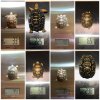On 15 December 2016, I received 4 hatchling Spb Leopard tortoise hatchlings. Here they are in the box in which they were shipped (I took them out of their individual deli cups).
Their shared enclosure was set up in the enclosed chamber style. Low temp end is 82F, higher temp end is 96F. The humidity is nice and high and their hide box utilizes moistened moss. Their water bowl is a terra cotta dish. They all, to this day, eat normally; they're given prepared diets(Mazuri/ZooMed/Marion) 3 days a week, then get fresh veggies with calcium & multi-vitamin powder on opposite 3 days. Like all of my young tortoises they are soaked 6 days a week, older tortoises (>4 yrs) get soaked twice a week.
At about 4 months it was pretty obvious that two were outgrowing the other two at a lopsided pace. To prevent the two smaller ones from being out-competed for food I separated them into two pairs expecting the two smaller ones to then start spurting. This did not happen. The two larger ones kept on trucking while the two smaller continued to just stagnate. The picture below shows each tortoise on the day I received them next to themselves 1 year later, 15 Dec 17.
The two smaller tortoises skyrocketed while the two heavier ones haven't even doubled their weight yet. The 49g tortoise is the only of the two that looks physically "off." Its name is valentine due to the heart shaped on its fwd most vertebral scute. On arrival the keratin of the shell seemed thin and appeared to follow the contours of the underlying ribs. That as you can see has corrected itself but one odd trait still remains, puffy skin, most prominent after eating.
This is a photo of Valentine at 8 months old exhibiting the skin puffing:

Valentine's partner in non-growth, Eclipse(48g hatchling), named for the waning moon shapes on vertebral scutes, does not have this odd post-meal puffing.
So my first thought was this text-book "Hatchling Failure Syndrome" as spelled out by Tom in his thread on the subject. What makes me have some doubt is the fact that only half of these guys are failing to grow. If the breeder screwed things up I would expect all to be little runts not just two. I also wouldn't expect them to have lasted a year. All four are active eaters, they drink when thirsty, all four wander around their respective enclosures and sleep where ever, when ever, crap regularly, etc. Behaviorally, all four are normal little Leos. Other than the pictured skin puff, nothing else seems odd or symptomatic of some other problem.
For further data I'm including screen shots of the charts I keep. The yellow numbers are SCL to OCL ratio that I recently began to track.
And in this chart you can see how their weights diverged rather early on:

After a year it is a mystery to me. I now ask this community, Hypotheses?

Their shared enclosure was set up in the enclosed chamber style. Low temp end is 82F, higher temp end is 96F. The humidity is nice and high and their hide box utilizes moistened moss. Their water bowl is a terra cotta dish. They all, to this day, eat normally; they're given prepared diets(Mazuri/ZooMed/Marion) 3 days a week, then get fresh veggies with calcium & multi-vitamin powder on opposite 3 days. Like all of my young tortoises they are soaked 6 days a week, older tortoises (>4 yrs) get soaked twice a week.
At about 4 months it was pretty obvious that two were outgrowing the other two at a lopsided pace. To prevent the two smaller ones from being out-competed for food I separated them into two pairs expecting the two smaller ones to then start spurting. This did not happen. The two larger ones kept on trucking while the two smaller continued to just stagnate. The picture below shows each tortoise on the day I received them next to themselves 1 year later, 15 Dec 17.

The two smaller tortoises skyrocketed while the two heavier ones haven't even doubled their weight yet. The 49g tortoise is the only of the two that looks physically "off." Its name is valentine due to the heart shaped on its fwd most vertebral scute. On arrival the keratin of the shell seemed thin and appeared to follow the contours of the underlying ribs. That as you can see has corrected itself but one odd trait still remains, puffy skin, most prominent after eating.
This is a photo of Valentine at 8 months old exhibiting the skin puffing:

Valentine's partner in non-growth, Eclipse(48g hatchling), named for the waning moon shapes on vertebral scutes, does not have this odd post-meal puffing.
So my first thought was this text-book "Hatchling Failure Syndrome" as spelled out by Tom in his thread on the subject. What makes me have some doubt is the fact that only half of these guys are failing to grow. If the breeder screwed things up I would expect all to be little runts not just two. I also wouldn't expect them to have lasted a year. All four are active eaters, they drink when thirsty, all four wander around their respective enclosures and sleep where ever, when ever, crap regularly, etc. Behaviorally, all four are normal little Leos. Other than the pictured skin puff, nothing else seems odd or symptomatic of some other problem.
For further data I'm including screen shots of the charts I keep. The yellow numbers are SCL to OCL ratio that I recently began to track.

And in this chart you can see how their weights diverged rather early on:

After a year it is a mystery to me. I now ask this community, Hypotheses?